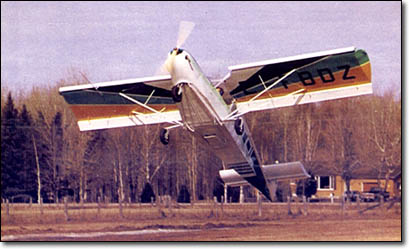This discussion has become ridiculous. I've long recommended that anyone interested in STOL flying in a Cessna needs to take an experienced pilot out to show them full flap go-arounds, full flap take-offs, and full flap MCA including steep turns. For Cessna drivers reading this thread? Please go do it. Do not internalize that a full flap/full trim/full power go-around will cause a pitch down or leave you with a level aircraft. It will not. The nose will rise and you'll need to apply significant forward yoke pressure to maintain speed and climb. That is a fact, not a theory. Please go try it for yourselves. This internet flying BS isn't what you'll need when you find yourself in the middle of a balked landing on a short strip with tall trees ahead. Flyer beware. Cheers.
Even my Robertson STOL equipped Cessna and the associated POH addendum doesn't recommend, nor authorize, a full flap takeoff. It's not particularly smart to do it in my aircraft.
It's a really really dumb idea to show them off in a non-STOL aircraft.
Mine is limited to 30 degrees for takeoff and Robertson (to limit their liability) calls them an "emergency" maneuver only in the POH addendum.
Of course not practicing them would quickly turn them into a real emergency, so I have no problem practicing them.
But I have zero reason to practice full flap 40 degree takeoffs. That's just more drag for very little change in lift.
Also at my typical altitudes for operation, MCA and steep turn combined won't be a level flight operation. Even with two on board and half tanks, you're going down during that.
It's often taught as an escape maneuver by mountain pilots to turn away from a ridge line. It has little to do with STOL unless you're mixing obstructed airports with STOL. Some are. But it'll be a lot more useful to most folks as a way to make a tight radius escape turn away from rising terrain, than useful for an unobstructed approach to a short strip. You typically just don't need to maneuver that much to line up with any but the most challenging backcountry runways.
The rest of the statement above about is correct about pitch and flaps in Cessnas. You'll have to push if you were trimmed for slow speed and add a gob of power.
I don't fly other brands much so I won't comment on those.
Here's a Flap 30 takeoff near sea level on about an 80F day. Trimmed for takeoff, right at the end of the video you can see that I had to push forward on the yoke to level off and gain another ten knots for flap retraction to 20. It would have come off another five knots slower but it leads to PIO when pushing and I hadn't done one in a while. No point horsing it into the air.
http://youtu.be/D01jHXn2q28
The setup for that takeoff was that our own Mr. David White had been doing STOL takeoffs at Gastons during the fly-in and showing off the capabilities of his STOL 172 by lifting off before the windsock. I was bored and felt like doing one. I tossed all the crap out of the 182 into the grass and cheated by going all the way back to the road, and holding the brakes on the grass until a wheel slid.
Me, iPad, headset, and about 40 gallons on board.
As far as STOL takeoffs go, this one was pretty benign and I wasn't trying very hard. I've gotten it off equally short at my home altitude which is a much more aggressive takeoff, and it's a very aggressive pitch up and off and pitch down to stay in ground effect and build speed.
It's always a joy to take the normally aspirated O-470 down near sea level. Lots of power. Fun.
About the only thing I regret about that week was not flying with friends more. The stories of bumming around in airplanes and flying in different types at Gastons from long time PoA folk sound more fun than sitting around talking, but for some reason I left the plane mostly parked. Newbie kinda going with the flow that weekend.
Next time, anyone wants to go try it should just ask. I'd go. No need to be too wild about it either, the airplane really likes it down there. Can go play on asphalt nearby too, if he grass is too wet. That year it was really dry.
Hopefully this year. We'll see.
A hardcore STOL takeoff in my aircraft has the stall horn going until the level acceleration to flap 20 retraction speed. That will kinda pucker you up the first few times and isn't how I like to demo the airplane to new folks. Too much chance their reflexes will trigger and they might help me push... Haha. The one in the video only got a brief buzz of the horn right at rotation. Solidly flying and not operating that far behind the curve for that takeoff.




